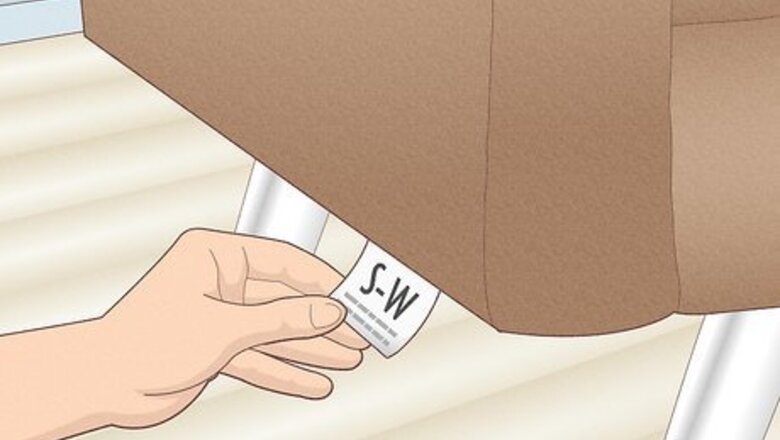
views
- Gently remove small stains using dish soap and water or baby wipes.
- Use rubbing alcohol or a Magic Eraser for more stubborn stains.
- Use baking soda to get rid of ink stains and cover up odors.
Check the couch’s tag to see what you can use.
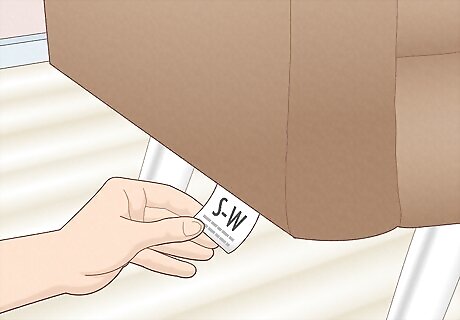
The label will indicate what will or won’t damage the couch. There are a ton of different ways to manufacture faux suede, so it’s extremely important to figure out what category of cleaner you’re allowed to use. Dig around behind and underneath your cushions to find the tag. On that tag, there will be a big letter (or two); this letter is the cleaning code. Here are what those letters on the label mean: W – You can only use water-based solutions (i.e. dish soap and water), or water alone. S – Water will leave a stain, so you must use a solvent (i.e. rubbing alcohol). S-W – You can use solvents and/or water. Basically, the world is your oyster and you can use whatever you want. X – You can use a vacuum, and that’s it. With an X label, you’re sort of stuck with stains unless you get the couch professionally cleaned.
Vacuum your suede to clean up crumbs or dust.

This is a great way to clean the couch without any liquids. Put the upholstery attachment onto your vacuum’s hose to do this. Those individual fibers on your faux suede couch may look like they’ll come loose from suction, but this is totally safe. Drag the hose over the dirty area to clean it. The brush may even restore the fiber’s nap! Stick the hose in between the cushions or seams to pull up any crumbs that have fallen in between. Do this once every 2-3 months to keep your couch well-maintained.
Use baby wipes to clean or wipe stains gently.
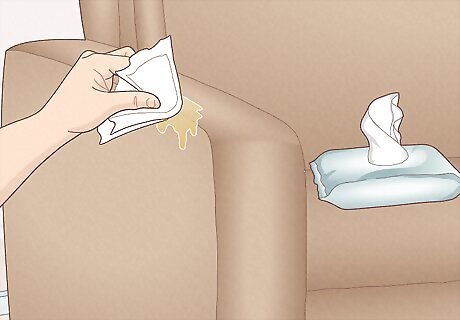
This is a good low-risk way to spot clean or remove blemishes. Baby wipes are a safe way to soak up spills or wipe away stains. While they are soaked in water, there isn’t nearly enough water in them to make them a risky option for S couches (don’t use them on X couches, though). Keep a stack of baby wipes in your side table so you can grab them quickly if anyone ever spills in the future. This may be a good way to clean up water stains as well!
Reach for rubbing alcohol as a safe option.
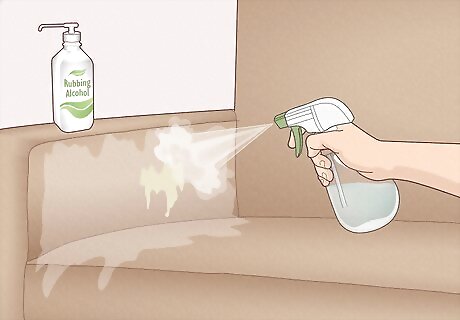
This is the ideal “heavy-duty” cleaner for any couch that can get wet. If a quick wipe with a cloth or baby wipe doesn’t do the trick, fill a spray bottle with rubbing alcohol and spray the stained or tainted area thoroughly. Then, use a clean sponge to wipe the area clean. Let the rubbing alcohol dissipate on its own when you’re done. Rubbing alcohol evaporates much faster than water, so you shouldn’t need to let the couch air out for too long.
Use dish soap for a water-based solution.
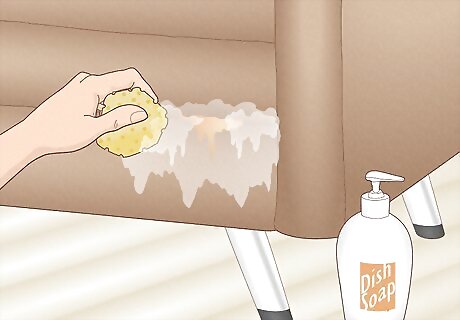
Dish soap is a safe, fragrant option for any couch that can handle water. Grab a sponge or microfiber cloth, add a pea-sized squirt of dish soap, and lather it up. Work the dish soap into the stain using smooth circular motions until the discoloration or stain is gone. Wipe the soapy residue up with a damp cloth. This is a pretty low-risk option. If you use water and you don’t have any success, try dish soap!
Rub stubborn residue away with a Magic Eraser.
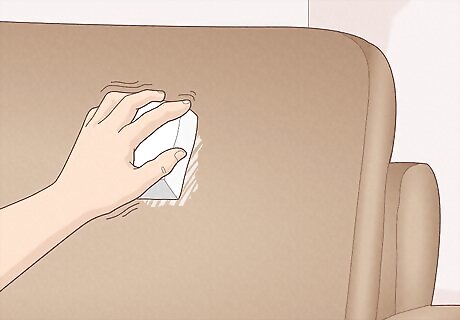
This is also a great option for dried liquids that stick to the fibers. Grab a Magic Eraser, activate it with a little bit of water, and gently wipe any obnoxious residue off of your couch. Use as little force as you possibly can—melamine, which is what Magic Erasers are made out of, can rip individual fibers out if you rub too hard. Since you have to get the eraser damp to activate it, be extremely careful when trying this on S couches. It may be fine since you aren’t using enough water to really get the material super wet, but spot test just to be safe.
Use baking soda and water for ink or paint.

Trickier materials can be eroded away with a baking soda paste. Fill a small container with a dollop of baking soda and add a little bit of water. Mix it up, and add water as needed, until you develop a thick paste. Lay this paste over the stained area using your finger or a clean cloth. Use a cloth or sponge to work the paste into the area and then use a clean, damp rag to wipe the paste up. You may need to do this multiple times to fully lift the ink or paint out.
Sprinkle baking soda over stains to cover up odors.

If a stain ever leaves a funk behind, baking soda can absorb the aroma. Sprinkle the aromatic area with a spoonful or two of baking soda. Let it sit for as long as you’d like before vacuuming the baking soda up. Repeat the process if you still get a whiff of anything unpleasant from the area. The longer you leave the baking soda on the area, the more effective it will be. You may be able to remove the odor in as little as 15 minutes, although it can take 12-24 hours to remove stronger aromas. You can also use white vinegar if you have a couch that can get water on it.
Clean oil-based stains with ethanol.
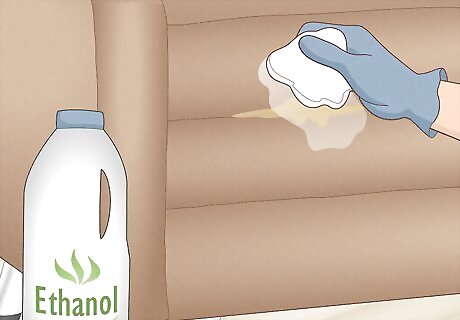
Ethyl alcohol is a stronger solvent, and it will get tougher oily stains out. Put on rubber gloves and grab a clean, white cloth. Pour a capful of ethanol into the cloth and gently blot the stain repeatedly. Continue doing this until the stain dissipates. Use a dry cloth to pat the excess ethanol up and let the area air dry. Ethyl alcohol is not the same thing rubbing or isopropyl alcohol. However, you can try using rubbing or isopropyl alcohol if you don’t have any ethyl alcohol available.
Brush the couch to restore the nap.

Once clean, you may need to breathe life back into the suede texture. The nap refers to the texture of the individual fibers. Grab a stiff fabric or suede brush and run it back and forth over the area you’ve just cleaned. This will wick the fibers up and restore your couch’s plush, comfortable texture. Use a comb or dry sponge if the strands of fabric aren’t bouncing back to their original form with the brush.
Spot test any cleaning product you plan to use.
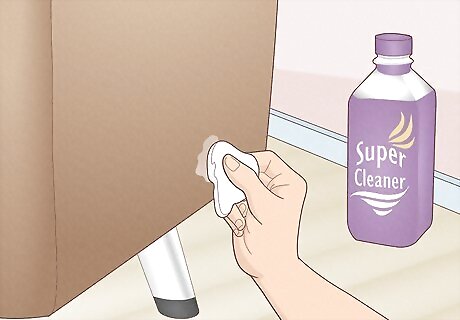
Find an area nobody will see and test any cleaner you want to use. Even if a label says it’s okay to use a certain cleaner, strange things can happen with faux suede when you apply liquid depending on how it was made. Give yourself a little peace of mind by spot-testing any cleaner before you apply it to a soiled area. Just rub a pea-sized dollop of your cleaner of choice into the inconspicuous area and wait a few minutes. If there’s no discoloration or damage, you’re probably good to go.
Soak up spills as soon as they happen.
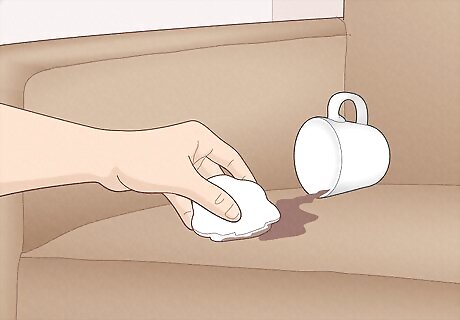
The faster you get to a spill the easier cleanup will be. Grab a microfiber cloth and soak up any spills as soon as you can. Blot the area with your towel (as opposed to rubbing back and forth) to avoid spreading the spill. This will prevent any spills from soaking into the fibers. If you have a couch that can get water on it, you can dampen your microfiber cloth with some water to make it more absorbent.
Spray the couch with a stain protector.
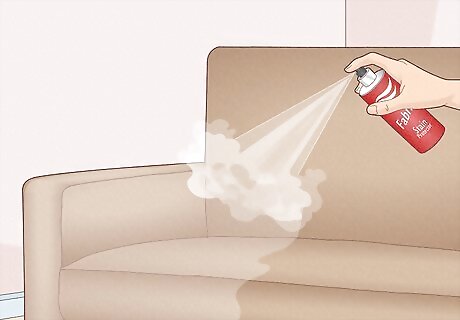
To prevent stains in the future, cover the fabric with a stain protector. Scotchgard is the popular option, but any fabric protector that lists polyester or upholstery in the list of protected materials should work. Follow the directions on the label to apply the stain protector to your sofa.

















Comments
0 comment